| |
| |
|
|
|
|
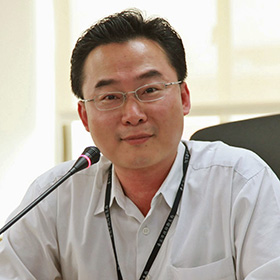 |
|
| |
Director Chao-kai Hsu
Education
- Department of Food Science, Fu Jen Catholic University
Experiences
- Food Division, Food and Drug Administration, Ministry of Health and Welfare
Currently
- Laboratory Director, Department of Health, Taipei City Government
|
|
| |
|
|
| |
| Food Safety Experts |
(Shu-han) |
1) Laboratory Director, Department of Health,
Taipei City Government
Time: May 23, 2014
Location: Laboratory, Department of Health, Taipei City Government
Introduction
Red on Tree uses toxic-free fruits to produce jams without additives, but we often see the news about processed food with harmful additives. We want to know about the additives in the food, whether all additives can be detected, the detection methods, and the principles to judge the additives, in order to help consumers identifying natural and healthy foods. We decided to visit the laboratory of Department of Health to search the answers to our questions.
Q1. What are the responsibilities of this laboratory? (Tsung-chun)
A1. Taipei City Government Laboratory is responsible for two main areas. One is the routine inspection on fields of food, drug and hygiene of business facilities, such as swimming pool water, bathing pool water, addition of Western medicine in traditional Chinese medicine, and detection of amebic dysentery. The other area is fee-based food inspection applied by citizens and manufacturers. Anyone can send in the sample for testing.
Q2. What are the main steps of food inspection by the government? What is the most difficult step? (Hui-yu)
A2. Food inspection is divided into pre-treatment and analysis. For different tests, there are different levels of difficulty. For example, it is relatively difficult to detect and analyze pesticide, because we need to test all compositions of the food before the pesticide detection. When testing the veterinary drugs, the most difficult part is the pre-treatment because we need to deal with animal corpses. The difficulties depend on the inspection method.
Q3. What is the most difficult inspection you have encountered? Are there examples that the chemical additives are close to the natural products? (Shu-han)
A3. There are two types of difficult inspection. One is the substance that has never been inspected, like plasticizer. It was never added to food before, so there was no relevant experience or benchmark for comparison. The second is similar substance. Drug makers would change the components of the drug to cheat the instruments. For example, some diet pills may contain similar components so that the test yields undetermined result. Caffeine and vitamin are also very close to natural substances. Sometimes it is very difficult to judge whether they are artificially added or natural.
| |
|
|
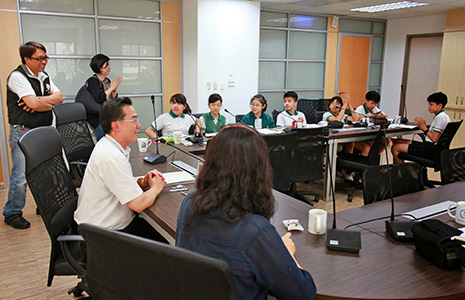 |
|
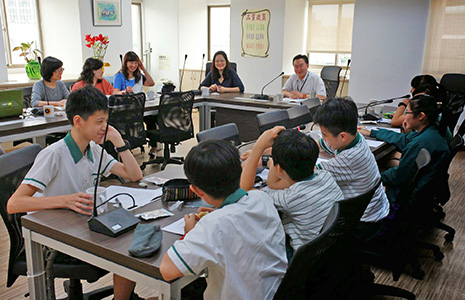 |
Meeting room, Department of Health |
|
Director Hsu explains the food inspection in a humorous manner. |
| |
|
|
Q4. For the foods sold in the market, what method can be used to preliminarily judge whether the substances harmful to human body are added? (Yin-cheng)
A4. This is also the doubt of many people. Food has its original color and taste. If the food has bright color, perfect appearance, or irritating odor, it is possible that some chemicals, like bleach or pesticide, are added. Noodles and bean curds with unnatural color should not be purchased. It is better to find a manufacturer with good reputation. To sum up, do not buy the foods with unnatural color, taste and appearance.
Q5. There are so many food components and additives, how to analyze all of them? Will this be a huge project? (Jie-sheng)
A5. Indeed it is a huge project. The main thing is that the inspection method should be recognized and the inspection result should be effective. The additives are diversified, at least over 2000 kinds. Is there an inspection method for each of them? The answer is no. The project is enormous, so we can only do our best step by step. How can the inspection method be recognized? The best way is to follow the procedures of the Ministry of Health and Welfare. Both the central and local governments can develop inspection methods. We take over 10,000 cases each year. This does not mean that we only inspect 10,000 items, but we need to inspect many items for each case. It is a heavy work load for out current staffing. We will make further efforts in the future, and also expect more talents to join our team.
| |
 |
| |
|
Q6. What are the differences in the detection for the juice and jam if claimed natural or not? What is the range of the food certification label? (Hui-yu)
A6. The inspection method of these foods is the same, and does not change over the product saying. The number of the food certification labels is determined according to the food safety regulations.
Q7. When the laboratory detects the nonconforming products or the products harmful to the human body, will the information of manufacturer be voluntarily disclosed to the public? (Tsai-chen)
A7. We will surely disclose the information by press release and on the website of the Department of Health. For some special cases, like plasticizer or adulterated oil, we will list the conforming and nonconforming manufacturers in the special area of the website.
Q8. Recently, there are many food safety issues in Taiwan. Does the laboratory have corresponding methods and measures? (Tsung-chun)
A8. The food safety problem should be drew high attention to Department of Health. The first part should be strengthen inspection, especially more inspections on the repeatedly violating manufactures and nonconforming products. The second part should be inspection at the origin, such as the wholesales market. Most of the vegetables and fruits in Taipei are transported from central and southern Taiwan (Yunlin). The first distribution place is the agricultural product transportation and sales center in Taipei. We conduct pesticide screening and inspection there. Once it is found that the pesticide exceeds the standard, the agricultural products will be sent to Department of Health for inspection. Related laws should also be amended. For example, in the oil incident, the Ministry of Health and Welfare amended the food safety management law, and increased the penalty to 50 to 60 million NTD. It is hoped that the high penalty will stop the illegal merchants from speculation.
| |
|
|
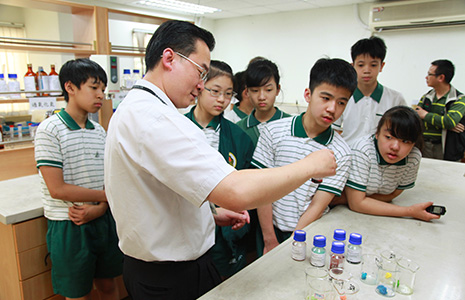 |
|
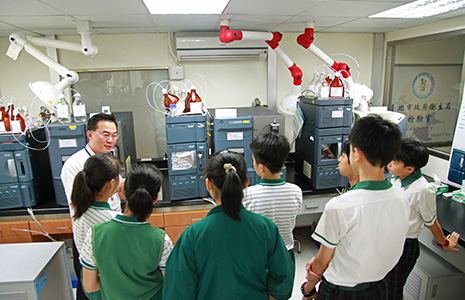 |
| |
|
|
Q9. Can we send suspicious foods for testing? (Yin-cheng)
A9. We provide the service of inspection for the citizens and manufacturers registered in Taipei City. The inspection fee is sponsored by the tax revenue of Taipei City Government, so only in Taipei City. The microorganism inspection fee is 1000 NTD, and that for chemical inspection is 2000 to 3000 NTD.
Q10. What are your happiest and saddest moments in the line of work? (Jie-sheng)
A10. The happiest moment is when I detect illegal products, especially detecting western drugs in health food. The health food containing western drugs does great harm to the human body, if it can be seized, many people can be protected. The saddest moment is when I cannot detect and seize all of the adulterated food completely. The nonconforming rate is almost 20% to 30% for the cases we process everyday. Perhaps this is the problem of the whole system, because the laboratory is only responsible for the final part of the food safety management chain.
| |
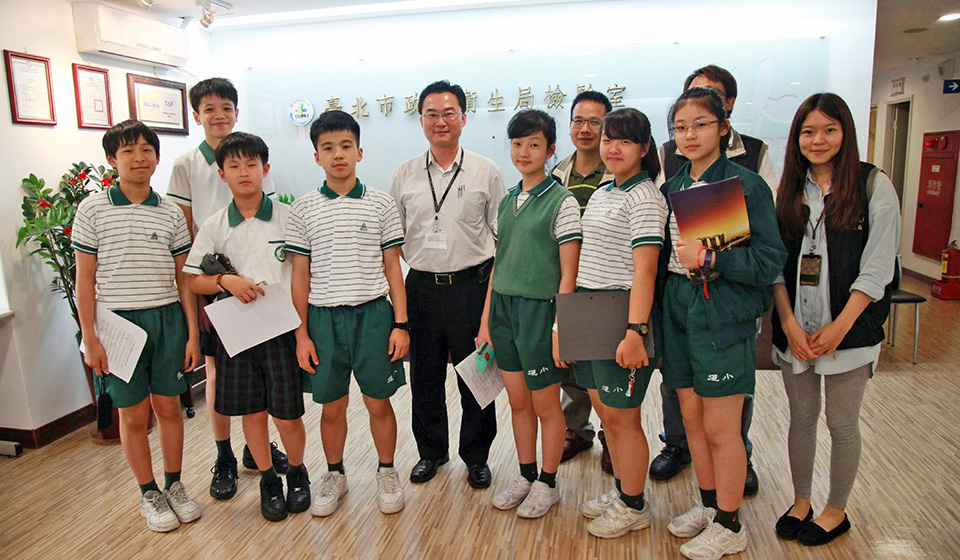 |
Group photo with Director Chao-kai Hsu |
| |
Conclusion
From the interview, we learnt that the inspection is not a simple work. There are many food additives beyond our imagination. In order to control the quality of food, the inspectors are detecting the problems like finding a needle in a haystack. On the other hand, we also realized the fact that some merchants ignore food safety for profit. Hence, we should promote the concept of food safety and cherish moral manufacturers, as well as urge the government to solve the problems at the source. We hope that the laboratory can be relieved from its heavy work load, and we could rest assure with the quality of food. |












